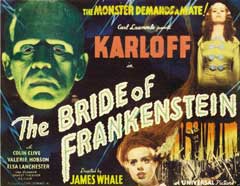Human Nature Starts Over: Reflections After Watching The Bride of Frankenstein On a recent Midnight dreary after a wearying week, I caught The Bride of Frankenstein on one of my local broadcast channels. I do not have cable, but I do have electricity and plumbing. Perhaps not since Count Gore DeVol ran Bride on Washington's Channel 20 in the '70s had I watched this film. What struck me during my reacquaintance was the abundance of distinctly Catholic symbols in its frames. There is the First Holy Communion class, one of whom is apparently murdered by the monster. He also scares a pack of little girls away from a roadside shrine of The Sacred Heart. A crucifix is in plain sight in the hut of the lonely, blind "hermit" as he is called in the credits and in cinematic exegis. One of the scenes prohibited by the censors was that of the monster rushing to rescue the corpus from a cross. Clearly habited as a Franciscan, the "hermit" is playing the Bach/Gounod Ave Maria when Frankenstein's project lumbers across him. Why? There were no Leo McCareys involved in the making of this 1935 movie, no one interested in plugging Holy Church. It appears that the producers wanted to shoot a film that would get by the industry's hyper-sensitive censors of the time. Elsa Lanchester, as Mary Shelley, states at the opening that she wrote Frankenstein to teach a moral lesson. Religious he was not, but director James Whale was enamored of Expressionism in German filmmaking. Expressionism made heavy use of symbols and icons. And when it comes to symbols and icons, nothing has them like Catholicism. Catholic symbols are really handy if you want to represent stuff such as goodness and innocence. There would be no such symbols for moviemakers to use were there no Catholicism. As he was not in the orignal Frankenstein, the monster in Bride is the protagonist, an object of pity. He did not ask to be assembled from corpse parts by an arrogant ghoul playing God in the name of science. He is a creature of his environment. His anger and fears are explained and understandable. He has an impulse to be benevolent when he rescues the shepherdess from drowning. His nascent sense of good and bad is nurtured by the solitary, sightless friar. The monster is, as Adam in Genesis was, alone. In the sequel how the creature came to be does not matter so much. He is human with a human nature. Neither can be made, or unmade, by Man. Henry Frankenstein, at least, paves his road to Hell with good intentions. Already regretting what he has done, he is further horrified when Dr. Pretorious shows him the little people, complex Sea-Monkeys®, that he has grown. "But this isn't science!" Frankenstein recoils. Yes, among scientists and those who fancy themselves to be scientific there are different ideas of what science is. For Dr. Pretorious the creation of human life seems to be for amusement. There is scholarship including a student's paper on the Notre Dame University web site--if such a monograph can be called scholarship--claiming that Dr. Pretorious with his kitschy Sea-Monkeys® is a "popular figure" among the Self-absorbed Sexual Minority because he was cast as a homosexual. Well, if Pretorious is a "popular figure," Flannery O'Connor was right when she discussed what it takes to recognize freaks. In declaring that he prefers death, Pretorious prefigures Jack Kevorkian who said "My specialty is death." Both Pretorious and Frankenstein assemble their woman in full confidence that she will automatically be the mate of the monster. The movie-watcher also is never allowed to wonder whether or not the two will become an item. Until Elsa Lanchester's first scream it seems to be inevitable. That the bride rejects the monster is a real sharp turn in the plot. It is also challenge to how people think about love, sex and marriage. Why does Elsa hiss at Karloff ? The answer is, basically, human nature. The makers of the monster and his intended bride set out to make human beings and human beings are what they get. As a cardinal who became the current pope wrote in Europe Today and Tomorrow, "Human nature starts over from the beginning in every human being." Through the human nature that He alone creates and the symbols that He inspires, God, whether He's invited or not, forces His way into human efforts, even movies. |
 |
|
Copyright 2011 by Neal J. Conway. All rights reserved.